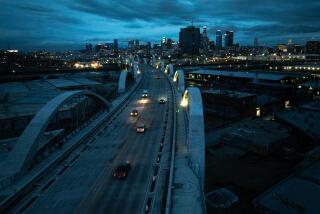Division Over Bridge : 2 Burbank Neighborhoods at Odds Over Plan to Tear Down Span
- Share via
Two Burbank neighborhoods are experiencing a real-life “Bridge Over Troubled Water.”
Unlike the Simon and Garfunkel standard, this particular bridge is not easing the minds of residents living in two neighborhoods linked by a pedestrian walkway over a flood control channel.
Urged by police and one contingent of angry residents, Burbank officials plan to tear down the 75-foot-long Elmwood Avenue footbridge between Lake Street and Victory Boulevard. Police said the bridge is used by gangs coming from the east side to terrorize residents on the west side.
But parents in the predominantly Latino community on the eastern side have launched a campaign to save the bridge. They say it is the only short and safe path for their children to get to school and have charged city officials and residents on the other side of the bridge with racism, contending they are being punished for the unlawful acts of a few.
“It’s not a gang issue; it’s a racial issue,” said Lorna Morgan, 31, an African-American switchboard operator whose 5-year-old son attends William McKinley Elementary School. “Burbank used to be all white, and now it’s changing. They just want to isolate us.”
Mike Perez, 21, the father of four school-age children, said: “Our children rely on that bridge. We’re being discriminated against. The people on the other side are mostly white and Armenian, and they don’t want us walking over there. We have to live with the gangs and the bullets every day.”
Perez said he and several other parents would appeal to the Burbank City Council on Tuesday to keep the bridge.
Residents of neighborhood west of the bridge, which is mostly white but also is home to various ethnic minorities, said gang members have harassed elderly people, stolen radios from cars, fired shots and walked down their streets displaying weapons.
“People are really afraid over here,” said one longtime resident who said she did not want to be identified for fear of retaliation. “We hear shooting two or three times a week. We want our little street back.”
One woman who has lived on Elmwood since 1964 added: “I don’t feel we’re being bad. We want to make it safer for the children too. It sounds like we’re being like the Gestapo, but we just want to clean up the neighborhood.”
A nine-foot-high locked gate installed on the bridge Sept. 18 to discourage gangs only widened the gap between the two communities. Children who used the bridge that morning discovered the locked gate on their way home. The abrupt closure infuriated several parents.
“They didn’t even tell us about the gate,” Perez said. “They just did it.”
City Manager Bud Ovrom admitted that the city didn’t fully understand the effect on schoolchildren. About 40 to 50 children use the bridge daily, he said.
“We didn’t realize the magnitude of the situation,” he said. “The school district told us that the bridge was not on their map of ‘safe routes.’ But a lot more children use it than we anticipated.”
A crossing guard now opens the gate in the morning and locks it in midafternoon after the children have returned home. But the city still plans to tear the bridge down.
“Gang members could still climb over the gate,” he said. “And kids could stand on each other’s shoulders and go over the gate. So that really won’t work.”
Ovrom also denied accusations that racism was behind the city’s decision. “There are lots of races on both sides of the fence,” he said. “Race has nothing to do with it. The police have said the bridge is too much of a problem.”
More to Read
Sign up for Essential California
The most important California stories and recommendations in your inbox every morning.
You may occasionally receive promotional content from the Los Angeles Times.














